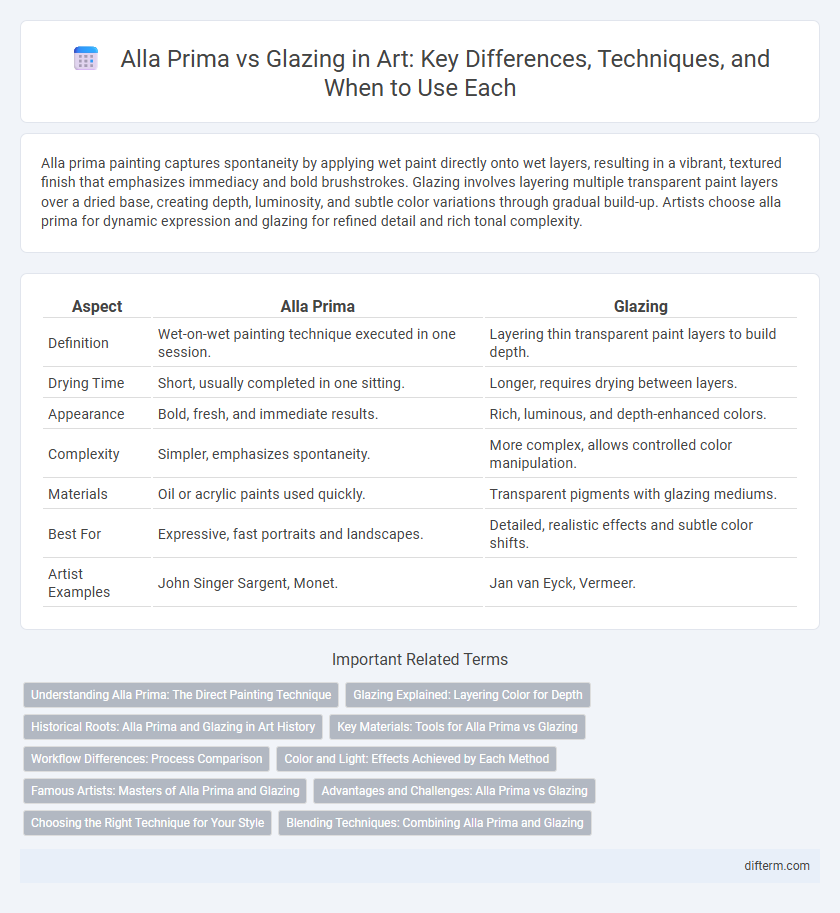Alla prima painting captures spontaneity by applying wet paint directly onto wet layers, resulting in a vibrant, textured finish that emphasizes immediacy and bold brushstrokes. Glazing involves layering multiple transparent paint layers over a dried base, creating depth, luminosity, and subtle color variations through gradual build-up. Artists choose alla prima for dynamic expression and glazing for refined detail and rich tonal complexity.
Table of Comparison
| Aspect | Alla Prima | Glazing |
|---|---|---|
| Definition | Wet-on-wet painting technique executed in one session. | Layering thin transparent paint layers to build depth. |
| Drying Time | Short, usually completed in one sitting. | Longer, requires drying between layers. |
| Appearance | Bold, fresh, and immediate results. | Rich, luminous, and depth-enhanced colors. |
| Complexity | Simpler, emphasizes spontaneity. | More complex, allows controlled color manipulation. |
| Materials | Oil or acrylic paints used quickly. | Transparent pigments with glazing mediums. |
| Best For | Expressive, fast portraits and landscapes. | Detailed, realistic effects and subtle color shifts. |
| Artist Examples | John Singer Sargent, Monet. | Jan van Eyck, Vermeer. |
Understanding Alla Prima: The Direct Painting Technique
Alla prima is a direct painting technique where artists apply wet paint layers in one session, allowing for spontaneous and expressive brushwork. This method contrasts with glazing, which involves building up transparent layers over time to achieve depth and luminosity. Alla prima demands swift decision-making and mastery of blending wet paints, creating vibrant, immediate compositions.
Glazing Explained: Layering Color for Depth
Glazing in painting involves applying thin, transparent layers of color over a dry underpainting to create luminous depth and rich tonal variations. Each glaze modifies the colors beneath it, allowing artists to build complex hues and subtle gradations with enhanced light reflection. This technique contrasts with Alla prima, which emphasizes wet-on-wet application and immediacy, while glazing prioritizes careful layering for optical depth and vibrancy.
Historical Roots: Alla Prima and Glazing in Art History
Alla prima painting, rooted in the 19th-century Impressionist movement, emphasizes wet-on-wet techniques that capture spontaneity and light with direct brushwork. Glazing, originating from Renaissance masters like Titian and Rembrandt, builds depth and luminosity through multiple transparent layers of oil paint. Both methods reflect distinct historical approaches to texture and light manipulation, influencing centuries of artistic expression.
Key Materials: Tools for Alla Prima vs Glazing
Alla prima painting requires thick, fast-drying oils and robust brushes such as hog bristle or synthetic filberts for bold, single-layer applications. Glazing relies on transparent oil mediums like damar varnish or stand oil and softer brushes like sable or synthetic mops to build delicate, translucent layers. Both techniques demand high-quality canvases or panels, but glazing favors ultra-smooth surfaces for optimal light reflection through layers.
Workflow Differences: Process Comparison
Alla prima painting involves applying wet paint directly onto wet layers, enabling a faster, more spontaneous workflow with immediate color blending and minimal drying time. In contrast, glazing requires multiple thin, transparent layers of paint applied sequentially over dried layers, resulting in a slower, more methodical process that builds depth and luminosity gradually. This workflow difference impacts both the time investment and the final visual texture of the artwork.
Color and Light: Effects Achieved by Each Method
Alla prima painting captures color and light with immediacy, blending wet layers on the canvas for vibrant, fresh hues and dynamic contrasts. Glazing multiplies luminosity and depth by applying transparent color layers over dried paint, enriching tones and producing subtle light reflections. Each technique manipulates color saturation and light interaction differently, influencing the artwork's visual texture and atmospheric presence.
Famous Artists: Masters of Alla Prima and Glazing
Famous masters of alla prima painting include John Singer Sargent and Joaquin Sorolla, renowned for their ability to capture vivid expressions with swift, wet-on-wet brushwork that emphasizes spontaneity and fresh color. In contrast, masters of glazing like Johannes Vermeer and Rembrandt harnessed layers of translucent paint to achieve luminous depth and subtle tonal gradations, meticulously building their compositions over time. Both techniques showcase distinct artistic approaches that highlight the interplay of light and texture in fine art painting.
Advantages and Challenges: Alla Prima vs Glazing
Alla prima painting offers the advantage of completing a work in a single session, allowing for vibrant, fresh brushstrokes and dynamic expression. Challenges include the need for precise timing and confidence, as corrections are difficult once the paint starts to dry. Glazing provides depth and luminosity through multiple translucent layers but demands patience, extended drying times, and meticulous layering to avoid muddiness or cracking.
Choosing the Right Technique for Your Style
Choosing between Alla prima and glazing depends on your desired finish and workflow. Alla prima offers a direct, wet-on-wet painting approach, ideal for capturing spontaneity and bold brushstrokes in one session. Glazing involves building up multiple translucent layers, creating depth and luminosity that suit detailed, refined styles.
Blending Techniques: Combining Alla Prima and Glazing
Blending techniques in painting can be enhanced by combining alla prima and glazing methods, where alla prima's wet-on-wet application allows smooth transitions and vibrant color mixing directly on the canvas. Glazing involves layering translucent washes of paint, creating depth and luminosity while refining color harmonies established in the alla prima base. This hybrid approach leverages alla prima's immediacy and glazing's complexity to achieve nuanced textures and rich visual effects in fine art.
Alla prima vs Glazing Infographic

 difterm.com
difterm.com